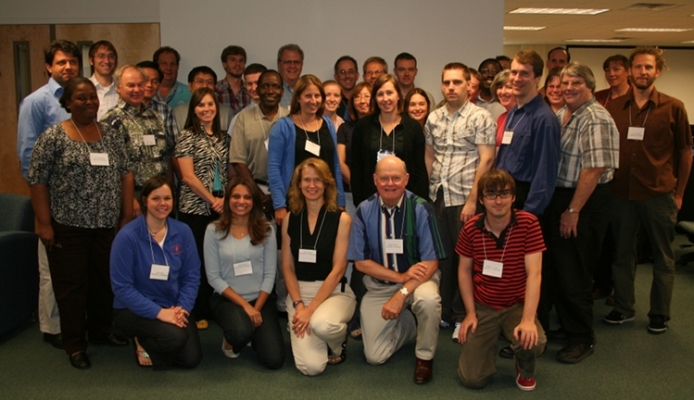| Description | Participants | Agenda | Summary | Products | Feature Article |
|---|
NIMBioS Investigative Workshop
Modeling Bovine Tuberculosis

Topic: Modeling the impact of cattle movements on transmission dynamics of bovine tuberculosis (M. bovis) in the United States
Meeting dates: July 7-9, 2009
Organizers:
Colleen Webb (Colorado State Univ., Depts. of Biology and Mathematics)
Agricola Odoi (Univ. of Tennessee, Dept. of Comparative Medicine)
Objectives. Bovine Tuberculosis (TB) is an infectious chronic disease found primarily in cattle but has been identified in many other species. The State and Federal Cooperative Bovine TB Eradication program, which began in 1917, has made significant progress decreasing the prevalence of M. bovis in humans and cattle. However, small pockets of M. bovis infection still exist in cattle and wildlife in the United States. In fiscal year 2008, the United States Department of Agriculture (USDA) spent approximately $31 million depopulating M. bovis affected herds, in addition to costs incurred for surveillance and control activities. In an effort to increase efficiency and effectiveness of TB control in the US, it is important to consider and assess other control strategies.
The use of disease simulation models is one method of exploring control options that could be used as alternatives to whole herd depopulation. Understanding cattle movement patterns as well as the connectivity of the various sectors of the U.S. cattle industry and incorporating these in the models would allow USDA Animal Plant Health Inspection Service (APHIS) Veterinary Services (VS) to develop more effective regulations and control strategies for various animal diseases, including bovine TB.
A number of interesting mathematical questions exist at the intersection of statistical and process-based models, and research on these approaches are relevant to the problem of modeling TB transmission. This Investigative Workshop brought together experts from across the globe to discuss cutting-edge approaches to model bovine TB transmission in the United States, with the goal of developing a model that would help inform policy on TB control strategies.
Evaluation report (PDF)
 Summary Report.
The NIMBioS Investigative Workshop on Bovine Tuberculosis convened July 7-9, 2009 with 37 participants from North America and Europe. Much of the progress in modeling bovine tuberculosis has been in European agricultural systems where cattle movement and disease spread data are quite detailed. This workshop investigated how modeling approaches developed for the European systems might be applied to the U.S. system, which differs quite significantly from the systems in Europe and where available data are not quite as detailed. Workshop organizers and participants plan to form a working group to develop models of cattle movement that would allow prediction of bovine TB spread and investigation of alternative control and eradication plans in the United States at both the state level (in states with high prevalence of bovine tuberculosis) and at the national level.
Summary Report.
The NIMBioS Investigative Workshop on Bovine Tuberculosis convened July 7-9, 2009 with 37 participants from North America and Europe. Much of the progress in modeling bovine tuberculosis has been in European agricultural systems where cattle movement and disease spread data are quite detailed. This workshop investigated how modeling approaches developed for the European systems might be applied to the U.S. system, which differs quite significantly from the systems in Europe and where available data are not quite as detailed. Workshop organizers and participants plan to form a working group to develop models of cattle movement that would allow prediction of bovine TB spread and investigation of alternative control and eradication plans in the United States at both the state level (in states with high prevalence of bovine tuberculosis) and at the national level.
Products
Publications
Tildesley MJ, Ryan SJ. 2012. Disease prevention versus data privacy: Using landcover maps to inform spatial epidemic models. PLoS Computational Biology, 8(11): e1002723. [Online]
Agusto FB, Lenhart S, Gumel AB, Odoi A. 2011. Mathematical analysis of a model for the transmission dynamics of bovine tuberculosis. Mathematical Methods in the Applied Sciences, 34(15): 1873-1887. [Online]
Presentations
Ryan SJ, Tildesley M. May 2012. Poster: Disease prevention or data privacy: Are landcover maps useful in informing spatial epidemic models? 2012 EEID Conference, Univ. of Michigan, Ann Arbor, MI.
Ryan SJ, Tildesley M. November 2011. Poster: The utility of land cover maps to inform spatial epidemic models of disease transmission in the UK livestock industry. EPIDEMICS3, 3rd International Conference on Infectious Disease Dynamics, Boston, MA.
NIMBioS Working Group, follow-up collaboration
Webb C, Odoi A. 2010-2011. Modeling the impact of cattle movements on transmission dynamics of bovine tuberculosis (Mycobacterium bovis) in the United States at local and national scales. NIMBioS. Accepted.
NIMBioS Investigative Workshops focus on broad topics or a set of related topics, summarizing/synthesizing the state of the art and identifying future directions. Workshops have up to 35 participants. Organizers and key invited researchers make up half the participants; the remaining participants are filled through open application from the scientific community. Open applicants selected to attend are notified by NIMBioS within two weeks of the application deadline. Investigative Workshops have the potential for leading to one or more future Working Groups. Individuals with a strong interest in the topic, including post-docs and graduate students, are encouraged to apply. If needed, NIMBioS can provide support (travel, meals, lodging) for Workshop attendees, whether from a non-profit or for-profit organization.
A goal of NIMBioS is to enhance the cadre of researchers capable of interdisciplinary efforts across mathematics and biology. As part of this goal, NIMBioS is committed to promoting diversity in all its activities. Diversity is considered in all its aspects, social and scientific, including gender, ethnicity, scientific field, career stage, geography and type of home institution. Questions regarding diversity issues should be directed to diversity@nimbios.org. You can read more about our Diversity Plan on our NIMBioS Policies web page. The NIMBioS building is fully handicapped accessible.
NIMBioS
1122 Volunteer Blvd., Suite 106
University of Tennessee
Knoxville,
TN 37996-3410
PH: (865) 974-9334
FAX: (865) 974-9461
Contact NIMBioS


